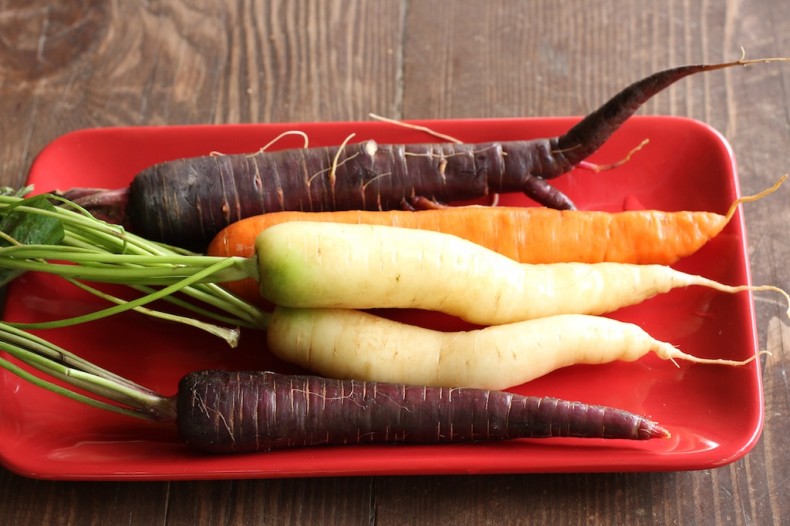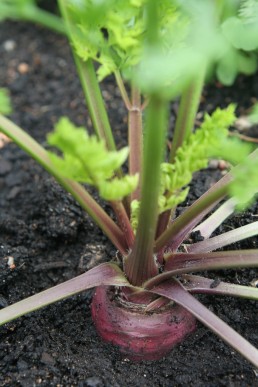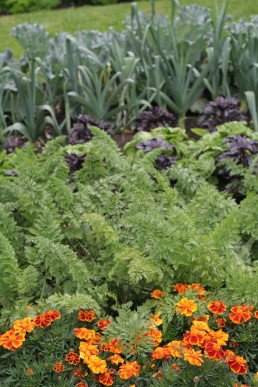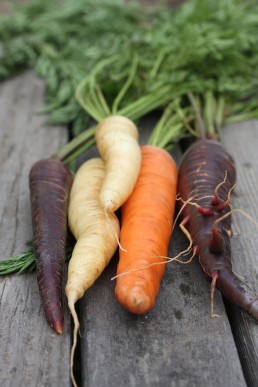Article and photos by Penny Woodward
The next few months are the perfect time to plant carrots of any colour in any region, but why not try purple carrots for a change? Purple carrots (Daucus carota Sativus Group ‘Purple Dragon’) were probably grown by early Romans who also grew white carrots, but it is believed that the first purple carrots came from Afghanistan, Pakistan and northern Iran. Purple, white and yellow carrots were imported to southern Europe in the 14th century and were widely grown in Europe into the 17th Century. Our familiar orange carrots only appeared in 16th century Holland when patriotic Dutch growers used seed from purple carrots and yellow Turkish carrots to produce orange roots, reflecting the colour of the ruling House of Orange. Over the ensuing centuries, orange carrots came to dominate and carrots of other colours were only preserved by growers in remote regions of the world. Purple carrots are still grown in Afghanistan where they are used by tribesmen to produce a strong alcoholic beverage.
Like all carrots, purple carrots are biennials that grow with the typically deeply divided bright green leaves in a dense clump with one long plump ‘carrot’ root to each clump. The edible roots have vibrant purple skins with bands of orange, yellow and purple flesh in the centre. The flavour is sweet and spicy and these carrots are great for salad, juicing and roasting. The root colour comes from pigments in the roots that have known health-giving properties. Orange and yellow roots contain beta-carotene, red carrots contain lycopene and purple, anthocyanins which act as anti-oxidants that protect the body. In the second year, if the carrots are not harvested, then strong upright leafy flower stems will grow from the centre of the clump. Usually carrots are harvested before they flower, but carrot flowers are great beneficial insect attractors so consider leaving some to go to set flowers and go to seed. The flowers of purple carrot varieties are typically rose-pink to lavender (orange carrots have white flowers) and occur in umbrella-like flower heads in late summer and surprisingly can make a delightful addition to the flower garden.
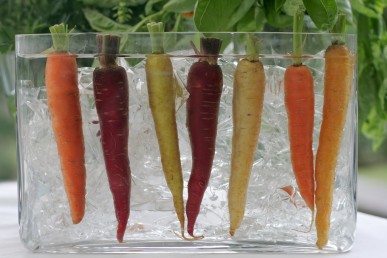 All carrots like a sunny position and light well-drained soils without lumps or stones that might cause the roots to split. Add compost and well-rotted manure before planting, and water regularly. Carrots don not like to be transplanted so grow them from seeds sown directly into the soil from September to February in rows 20 cm apart. Thin seedlings so that there is about 10 cm between each plant. Start harvesting young carrots after about two months.
All carrots like a sunny position and light well-drained soils without lumps or stones that might cause the roots to split. Add compost and well-rotted manure before planting, and water regularly. Carrots don not like to be transplanted so grow them from seeds sown directly into the soil from September to February in rows 20 cm apart. Thin seedlings so that there is about 10 cm between each plant. Start harvesting young carrots after about two months.
For those wanting to find out more go to the web site of the World Carrot Museum
John from the Carrot Museum has just let me know that: ‘It is not abundantly clear that orange carrots came from a cross between purple and yellow. The current thinking is that the Dutch developed deep yellow varieties. There is also some compelling evidence that orange existed in ad 500!’
Seeds of Purple Dragon carrots can be obtained from Diggers and Green Harvest among others.

